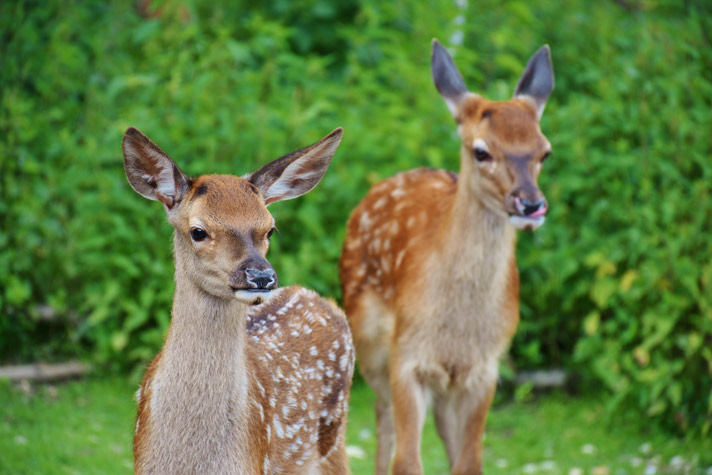The Literary Gardener – March 2017
“Everything in the forest has its season. Where one thing falls, another grows.
Maybe not what was there before, but something new and wonderful all the same.”
~Felix Salten, Bambi, A Life in the Woods, 1923
Twenty years before Walt Disney produced what has become a classic animated film, “Bambi” was written as an adult novel and published in Austria where it received wide critical acclaim. In 1928, a former Soviet spy named Whittaker Chambers translated the book from German into English. Since then, 200 editions of the novel have been printed in more than 30 languages. It’s considered one of the first “environmental novels” ever published.
Unfortunately, original first editions are difficult to find because German Nazis considered the story of Bambi to be a political allegory referring to the treatment of Jews; thus, many copies of the book were burned. However, English editions of Salten’s novel are available; among them is a paperback with black and white illustrations by Barbara Coony, and a hardback adapted for young readers by Janet Schulman with beautiful illustrations of oil paintings by Steve Johnson.
While literary gardeners may wish to have “Bambi” on their bookshelves, having deer in our flowerbeds is quite another story. Here, then, are my picks for 10 shade-loving groundcovers that would be right at home in Bambi’s forest, or in our shady gardens. These low-growing perennials are beautiful, suitable to grow in our area—and deer resistant! For my top 10 choices for sun-loving groundcovers that are deer resistant, check out my blog at: http://blogs.esouthernoregon.com/theliterarygardener/. The OSU Extension Service also provides a listing of deer-resistant flowers, shrubs and trees.
- Ajuga reptans ‘Black Scallop’ (carpet bugle)—The leaves are glossy and dark; purple flower stalks bloom mid to late spring, attracting bees and hummingbirds. The plant tolerates a variety of soils as well as some morning sun.
- Asarum caudatum (wild ginger)— This is a native rhizomatous plant. Its leathery evergreen leaves give off a ginger scent when rubbed. It also has unusual maroon flowers that bloom in late winter/early spring. Wild ginger attracts butterflies and tolerates a variety of soils.
- Brunnera macrophyllum ‘Jack Frost’ (Siberian bugloss)—This rhizomatous perennial has textured 8-inch leaves that are dark green with a frosting of white. Sprays of light blue flowers appear to float above the foliage in the springtime. Brunnera need moist, nutrient-rich soils that drain well.
- Cyclamen hederifolium ‘Silverleaf’ (hardy cyclamen)—‘Silver Leaf’ cultivars have heart-shaped silvery green leaves. The foliage emerges in the fall after the pink or white flowers, which bloom in September on bare 6-inch stems. Cyclamen are important pollinator plants for bees. They need rich, well-drained soil and protection from too much summer moisture.
- Helleborous x hybridus ‘Golden Lotus’ (hellebore)—Horticulturalist Marietta O’Byrne of Eugene, Oregon hybridized this stunning strain of late winter-blooming hellebore. Large, fluffy, fully double flowers range from pale to lemon yellow. Some are marked with beautiful burgundy speckling, shading, or edging. Attractive deep-green leaves are palmate and finely toothed. Hellebores are deep-rooted plants that thrive in nutrient-rich soil. They tolerate drought once established.
- Lamium maculatum ‘Purple Dragon’ (dead nettle)—Deep purple flower clusters that bloom in late spring provide a stunning contrast to silver leaves with dark-green edging. The plant will tolerate some sun and a variety of soils. It also makes a good container plant. The common name is bit unsettling, but it only means that it doesn’t smart when touched like its relative, stinging nettle.
- Liriope muscari ‘Royal Purple’ (lilyturf, monkey grass)—Narrow, grass-like leaves are evergreen; spiky purple flowers bloom in late summer. This plant thrives in moist, loamy, slightly acidic soil in the shade or partial sun. The flowers attract hummingbirds.
- Pulmonaria longifloria ‘Roy Davidson’ (lungwort)—This rhizomatous plant has green leaves with silver speckles that were once said to resemble a diseased lung, thus the unfortunate common name. Never mind—the plant’s pretty foliage and large, funnel-shaped flowers that bloom pink in early spring and mature to sky blue make it a popular shade garden plant. It needs nutrient-rich, moist soil that drains well.
- Vinca minor ‘Bowles’ (creeping periwinkle, creeping myrtle)—Evergreen leaves provide a striking background to violet flowers that bloom in mid to late spring. It’s a slow grower, but once established it is effective in smothering weeds. The plant thrives in a variety of soils and tolerates some sun and dry periods.
- Viola ‘Heartthrob’ (hardy violet)—A quick-spreading perennial, this cultivar has beautiful, deep-green leaves with a burgundy center. The fragrant lavender flower is long lasting and attracts butterflies. It grows well in moist, well-draining soil rich with organic matter. It can also be grown as a houseplant.
Walt Disney added Bambi’s adorable friends, Thumper the rabbit and Flower the skunk, to his 1942 animated film in order to lighten-up the story for young audiences. In the movie, Thumper laughs when Bambi mistakes the skunk for a flower but the shy skunk says, “Oh, that’s all right. He can call me a flower if he wants to.” The same can be said for the deer-resistant plants I’ve mentioned here—they can be called groundcovers or flowering perennials. Either way, they add long-lasting beauty to our gardens.

 Rhonda Nowak is a teacher, writer and gardener who lives and works in the Rogue Valley. She has taught literature and language arts for 25 years, the last six at Rogue Community College. In addition to her column for the Jacksonville Review, she writes a weekly column and blog called the Literary Gardener for the Mail Tribune. She also writes articles for Southern Oregon Wine Scene magazine and is writer and editor of Ashland Living magazine. Email Rhonda at Rnowak39@gmail.com.
Read more on her blog at
Rhonda Nowak is a teacher, writer and gardener who lives and works in the Rogue Valley. She has taught literature and language arts for 25 years, the last six at Rogue Community College. In addition to her column for the Jacksonville Review, she writes a weekly column and blog called the Literary Gardener for the Mail Tribune. She also writes articles for Southern Oregon Wine Scene magazine and is writer and editor of Ashland Living magazine. Email Rhonda at Rnowak39@gmail.com.
Read more on her blog at